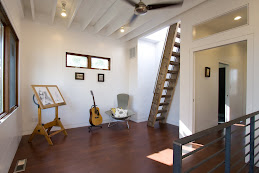Bill Curran (http://www.billcurrandesign.com/index.html) will be building and installing our stairs for us. Not only does Bill do beautiful work at a competitive price but he is also very accommodating and an extremely nice guy. He was also excited to be a part of our project and strongly supports what we're doing. We were immediately drawn to the clean, modern design sensibility of his work. Check out his site and make sure you scroll through all the images. His shop is in Philly just north of Chinatown, which he invited us to for our first design meeting. He lives above the shop in an amazing renovated industrial loft that basically acts as his showroom as he designed and fabricated almost all the furnishings (stairs, furniture, kitchen, etc). It was very impressive and very reassuring.
We have always had a pretty clear idea of what we wanted our stair to look like (and provided those details in the original set of drawings) and it was nice to find a high quality fabricator that was willing to build what we designed but was also able to help us refine the design and make it even better...and all within our budget. The basic design is fairly simple: an open riser stair with steel stringers, steel rod "ship-ladder" style railings, and wood treads. Very similar to the image below (which is from Bill's website.) The main difference is that we will have two stringers (opposed to the single, center stringer you see in the photo) and our railing posts are perpendicular to the top handrail, and the angle of the stair (opposed to perpendicular to the ground, as in the photo).

One important detail that we were always struggling with was the thickness of the wood tread. You see, when you have an open-riser stair, according to the residential building code, the open space between the top of one tread and the bottom of the next (essentially, part of the riser) cannot exceed 4" high (or as the code states: "must reject a 4" sphere"). Why a 4" sphere? Well, that's basically the size of a baby's head. This max. dimension was determined so that no one climbing the stairs could ever fall through the riser space. Makes sense. BUT, when your overall riser height is 7-3/4", the tread thickness (or the solid portion of the riser) needs to be a min. 3-3/4". Good luck finding wood that thick that is first, reasonably priced, and second, reclaimed timber. Basically, we needed a 4" x 10" (actual, not nominal) piece of wood. Over the past couple of months, this was proving to be a difficult find. Oh, and just so there's no confusion, the stair in the photo does not actually meet code and most likely received some sort of variance...which is totally feasible but we were trying to avoid any variances.
Also, the other drawback to this design was the tread was pretty bulky. So when we were going over all this with Bill, he presented a few possible alternatives. One of them involved adding a piece of steel that would connect the two steel angle supports (welded to the stringers that reach out to support the treads). This piece of steel would essentially run parallel with the tread nosing and set back about an inch. This allowed us to go back to a 2" thick wood tread and still meet code. The sketch below illustrates what I am talking about. The new steel piece is indicated in red.

One last detail that we went back and forth on was whether to go with 1/2" round rods or 1/2" square tubes for the balustrade. In the end, we decided on square as we thought it looked cleaner and aligned more with the overall design.
So how does sustainability factor into this feature? Well, there are a couple of different ways to approach a steel fabricated item such as a stair. One is to request that the item is made with salvaged steel. When doing something as precise and detailed as a stair, this can prove to be difficult because it will be hard to find the exact size and quantity of the pieces you need...never mind the condition the steel might be in if you plan on having them exposed. The other is to simply recognize that all steel that comes from a mill these days already has a high recycled content, sometimes up to 95%. And, of course, it's 100% recyclable. Therefore, simply choosing to build with steel is already a pretty green choice. So the main issue after that is to try and get your design locally fabricated. We have accomplished this. We are using another material in this stair though, and that is wood, for the treads. We will be acquiring reclaimed timbers (probably through our connection at Greenable) to use for the treads. The species will most likely be Chestnut, Elm, or Doug Fir.
And one last note. We also got Bill to fabricate us some steel posts for the railing up on the roof deck. For this rail we will be using stainless steel cables opposed to rods. This way, when your hanging out on the deck enjoying the green roof and the skyline views, the railing for the most part, simply disappears.








1 comment:
Ive worked with Bill Curran in the past. He ius very talented and a pleasure to work with. His work is solid and creative, and he is a man of his word. He gets the job done at a very reasonable price. Glad to see he is part of this amazing project.
Post a Comment